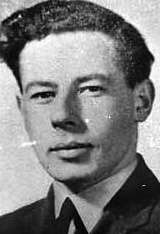Bob Yule
| Bob Yule | |
|---|---|
 Robert Duncan Yule | |
| Nickname(s) | Bob |
| Born |
29 January 1920 Invercargill, New Zealand |
| Died |
11 September 1953 (aged 33) London, England |
| Allegiance | |
| Service/branch |
|
| Years of service | 1939 – 1953 |
| Rank | Wing Commander |
| Unit | |
| Commands held | No. 66 Squadron RAF |
| Battles/wars | |
| Awards | |
Robert Duncan "Bob" Yule, DSO,[1] DFC,[2] and Bar[3] (29 January 1920 – 11 September 1953)[4] was a New Zealand born officer and fighter pilot of the Royal Air Force (RAF) during the Battle of Britain and Second World War.[5]
Early life
The son of a dental surgeon, Yule was born on 29 January 1920 in Invercargill, New Zealand.[6] In early 1938, Yule won a scholarship to the Royal Air Force College Cranwell and on 10 March 1938, he embarked on the vessel Rangitiki for England.[5] Yule began the course in April the same year. At the outbreak of the Second World War in September 1939, Yule joined 145 Squadron, a newly reformed fighter unit. He was granted pilot officer on probation status on 23 October 1939.[7]
Military career
World War II
On 18 May 1940, Yule took part in 145’s first action of the war. On patrol over Brussels, 12 Heinkel He 111's were intercepted in broken cloud and when the German bombers emerged from cover the Hurricanes attacked, Yule shooting one down. Four days later he destroyed a Junkers Ju 87.[8] During the Battle of Britain Yule destroyed a Ju88 and damaged three more, but on 25 October, he was himself shot down by a Messerschmitt Bf 109 in combat over Kent and was admitted to hospital with leg wounds after making a forced landing which completely wrote off his Hurricane.[8] Yule was confirmed at the rank of pilot officer on 23 October 1940.[9]
Yule rejoined 145 Squadron in February 1941, but shortly afterwards was posted away to be an instructor. He helped instruct American pilots, very much under secrecy because the USA was still neutral. In early November 1941, he returned to operations with 501 Squadron remaining with the unit for seven months and performing many operational sorties. In April 1942, Yule was promoted to Squadron Leader and in June that year he took command of 66 Squadron[8] and was awarded the Distinguished Flying Cross.[10] His citation read:
Flight Lieutenant Yule took part in operations in France in May, 1940, and subsequently fought in the Battle of Britain. He is a keen and courageous fighter pilot, and he has destroyed at least 5 hostile aircraft and damaged 4 others.[2]
Whilst leading a squadron sweep over the Cherbourg area on 15 July 1942, Yule engaged in combat with 2 FW 190's. He destroyed one, which exploded and crashed into the sea, and the other was last seen flying inland with its engine smoking.[8] In mid November 1942, having completed his first tour, Yule was posted to general office duties and was awarded a Bar to his DFC.[11] His citation read:
Since being awarded the Distinguished Flying Cross in February this year, Squadron Leader Yule has displayed untiring devotion to duty, fine fighting spirit and excellent leadership which have been an example of the highest order. He has participated in many operational sorties and in the combined operations at Dieppe. He has destroyed several and damaged a number of other enemy aircraft.[3]
In August 1943, Yule was promoted to Wing Commander of 66 Squadron and recommenced operational flying. After leading the Wing on many operational sorties, he was posted away in early March and awarded the Distinguished Service Order. His citation read:
This officer has led large formations of aircraft on very many sorties and has displayed skill and determination of the highest order. He is a splendid leader, whose sterling qualities have impressed all. He has rendered much meritorious service.[1]
Later career and death
Yule went on to planning duties, involving fighter wings of the 2nd Tactical Air Force in the coming Normandy invasion. He continued with these duties into 1945 and at war’s end was on a RAF Staff College course. While rehearsing for the Battle of Britain flypast over London on 11 September 1953, Yule collided with another jet aircraft. Faced with a densely populated area, Yule steered his aircraft towards Woolwich Arsenal and crash-landed between rows of buildings. Yule was killed in the crash.[5][8]
References
- 1 2 The London Gazette: (Supplement) no. 36429. p. 1706. 17 March 1944. Retrieved 2011-05-23.
- 1 2 The London Gazette: (Supplement) no. 35528. p. 1281. 17 April 1942. Retrieved 2011-05-23.
- 1 2 The London Gazette: (Supplement) no. 35791. p. 5031. 20 November 1942. Retrieved 2011-05-23.
- ↑ "Personal Details: Yule, Robert Duncan". Armed Forces Memorial roll of honour. GOV.UK. Retrieved 23 May 2015.
- 1 2 3 Robert Duncan Yule. Auckland War Memorial Museum: Cenotaph Record. Retrieved 2011-05-23.
- ↑ Yule, Robert Duncan Archived 20 March 2012 at the Wayback Machine.. The Pro Patria Project. Retrieved 2011-05-23.
- ↑ The London Gazette: (Supplement) no. 34727. p. 7501. 23 October 1939. Retrieved 2011-05-23.
- 1 2 3 4 5 Wing Commander Robert Duncan Yule. New Zealand Fighter Pilots Museum. Retrieved 2011-05-23.
- ↑ The London Gazette: (Supplement) no. 35005. p. 6861. 3 December 1940. Retrieved 2011-05-23.
- ↑ More decorations. Evening Post, Volume CXXXIII, Issue 90, 17 April 1942, Page 6. Retrieved 2011-05-23.
- ↑ Personal Items. Evening Post, Volume CXXXIV, Issue 129, 27 November 1942, Page 3. Retrieved 2011-05-23.
Further reading
- Wynn, K. (1981). A clasp for "The Few". Published by Auckland, N.Z. OCLC 316813027.